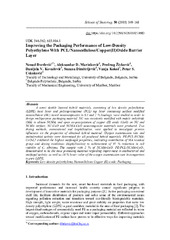Improving the Packaging Performance of Low-Density Polyethylene With PCL/Nanocellulose/Copper(II)Oxide Barrier Layer
Аутори
Đorđević, NenadMarinković, Aleksandar

Živković, Predrag M.

Kovačević, Danijela
Dimitrijević, Suzana

Kokol, Vanja
Uskoković, Petar

Чланак у часопису (Објављена верзија)
Метаподаци
Приказ свих података о документуАпстракт
A novel double layered hybrid materials, consisting of low density polyethylene (LDPE) base layer and polycaprolactone (PCL) top layer containing surface modified nanocellulose (NC) based nanocomposites in 0.5 and 2% loadings, were studied in order to design multipurpose packaging material. NC was covalently modified with maleic anhydride (MA) to obtain NCMA, and upon co-precipitation of copper (II) oxide (CuO) on NC and NCMA surface, NC-CuO and NCMA-CuO nanocomposite materials were produced. Two drying methods, conventional and lyophilization, were applied to investigate process influences on the properties of obtained hybrid material. Oxygen transmission rate and antimicrobial activity were determined for all produced hybrid materials. PE-PCL-NCMA-CuO-L2 exhibited the highest antifungal properties, indicating contribution of MA residual group and drying conditions (liophylisation) to achievement of 97% reduction in cell viability of C. albicans. The sample with 2% of NCMA-CuO, PE-PCL...-NCMA-CuO2, demonstrated to be the most promising material regarding improvment in antibacterial and antifugal activity, as well as 16% lower value of the oxygen transmission rate in comparison to pure LDPE.
Кључне речи:
Low-density polyethylene / Nanocellulose: Copper (II) oxide / PackagingИзвор:
Science of Sintering, 2018, 50, 2, 149-161Издавач:
- Međunarodni Institut za nauku o sinterovanju, Beograd
Финансирање / пројекти:
- Синтеза, развој технологија добијања и примена наноструктурних мултифункционалних материјала дефинисаних својстава (RS-MESTD-Integrated and Interdisciplinary Research (IIR or III)-45019)
DOI: 10.2298/SOS1802149D
ISSN: 0350-820X
WoS: 000452975300002
Scopus: 2-s2.0-85051437794
Институција/група
Tehnološko-metalurški fakultetTY - JOUR AU - Đorđević, Nenad AU - Marinković, Aleksandar AU - Živković, Predrag M. AU - Kovačević, Danijela AU - Dimitrijević, Suzana AU - Kokol, Vanja AU - Uskoković, Petar PY - 2018 UR - http://TechnoRep.tmf.bg.ac.rs/handle/123456789/3894 AB - A novel double layered hybrid materials, consisting of low density polyethylene (LDPE) base layer and polycaprolactone (PCL) top layer containing surface modified nanocellulose (NC) based nanocomposites in 0.5 and 2% loadings, were studied in order to design multipurpose packaging material. NC was covalently modified with maleic anhydride (MA) to obtain NCMA, and upon co-precipitation of copper (II) oxide (CuO) on NC and NCMA surface, NC-CuO and NCMA-CuO nanocomposite materials were produced. Two drying methods, conventional and lyophilization, were applied to investigate process influences on the properties of obtained hybrid material. Oxygen transmission rate and antimicrobial activity were determined for all produced hybrid materials. PE-PCL-NCMA-CuO-L2 exhibited the highest antifungal properties, indicating contribution of MA residual group and drying conditions (liophylisation) to achievement of 97% reduction in cell viability of C. albicans. The sample with 2% of NCMA-CuO, PE-PCL-NCMA-CuO2, demonstrated to be the most promising material regarding improvment in antibacterial and antifugal activity, as well as 16% lower value of the oxygen transmission rate in comparison to pure LDPE. PB - Međunarodni Institut za nauku o sinterovanju, Beograd T2 - Science of Sintering T1 - Improving the Packaging Performance of Low-Density Polyethylene With PCL/Nanocellulose/Copper(II)Oxide Barrier Layer EP - 161 IS - 2 SP - 149 VL - 50 DO - 10.2298/SOS1802149D ER -
@article{
author = "Đorđević, Nenad and Marinković, Aleksandar and Živković, Predrag M. and Kovačević, Danijela and Dimitrijević, Suzana and Kokol, Vanja and Uskoković, Petar",
year = "2018",
abstract = "A novel double layered hybrid materials, consisting of low density polyethylene (LDPE) base layer and polycaprolactone (PCL) top layer containing surface modified nanocellulose (NC) based nanocomposites in 0.5 and 2% loadings, were studied in order to design multipurpose packaging material. NC was covalently modified with maleic anhydride (MA) to obtain NCMA, and upon co-precipitation of copper (II) oxide (CuO) on NC and NCMA surface, NC-CuO and NCMA-CuO nanocomposite materials were produced. Two drying methods, conventional and lyophilization, were applied to investigate process influences on the properties of obtained hybrid material. Oxygen transmission rate and antimicrobial activity were determined for all produced hybrid materials. PE-PCL-NCMA-CuO-L2 exhibited the highest antifungal properties, indicating contribution of MA residual group and drying conditions (liophylisation) to achievement of 97% reduction in cell viability of C. albicans. The sample with 2% of NCMA-CuO, PE-PCL-NCMA-CuO2, demonstrated to be the most promising material regarding improvment in antibacterial and antifugal activity, as well as 16% lower value of the oxygen transmission rate in comparison to pure LDPE.",
publisher = "Međunarodni Institut za nauku o sinterovanju, Beograd",
journal = "Science of Sintering",
title = "Improving the Packaging Performance of Low-Density Polyethylene With PCL/Nanocellulose/Copper(II)Oxide Barrier Layer",
pages = "161-149",
number = "2",
volume = "50",
doi = "10.2298/SOS1802149D"
}
Đorđević, N., Marinković, A., Živković, P. M., Kovačević, D., Dimitrijević, S., Kokol, V.,& Uskoković, P.. (2018). Improving the Packaging Performance of Low-Density Polyethylene With PCL/Nanocellulose/Copper(II)Oxide Barrier Layer. in Science of Sintering Međunarodni Institut za nauku o sinterovanju, Beograd., 50(2), 149-161. https://doi.org/10.2298/SOS1802149D
Đorđević N, Marinković A, Živković PM, Kovačević D, Dimitrijević S, Kokol V, Uskoković P. Improving the Packaging Performance of Low-Density Polyethylene With PCL/Nanocellulose/Copper(II)Oxide Barrier Layer. in Science of Sintering. 2018;50(2):149-161. doi:10.2298/SOS1802149D .
Đorđević, Nenad, Marinković, Aleksandar, Živković, Predrag M., Kovačević, Danijela, Dimitrijević, Suzana, Kokol, Vanja, Uskoković, Petar, "Improving the Packaging Performance of Low-Density Polyethylene With PCL/Nanocellulose/Copper(II)Oxide Barrier Layer" in Science of Sintering, 50, no. 2 (2018):149-161, https://doi.org/10.2298/SOS1802149D . .


